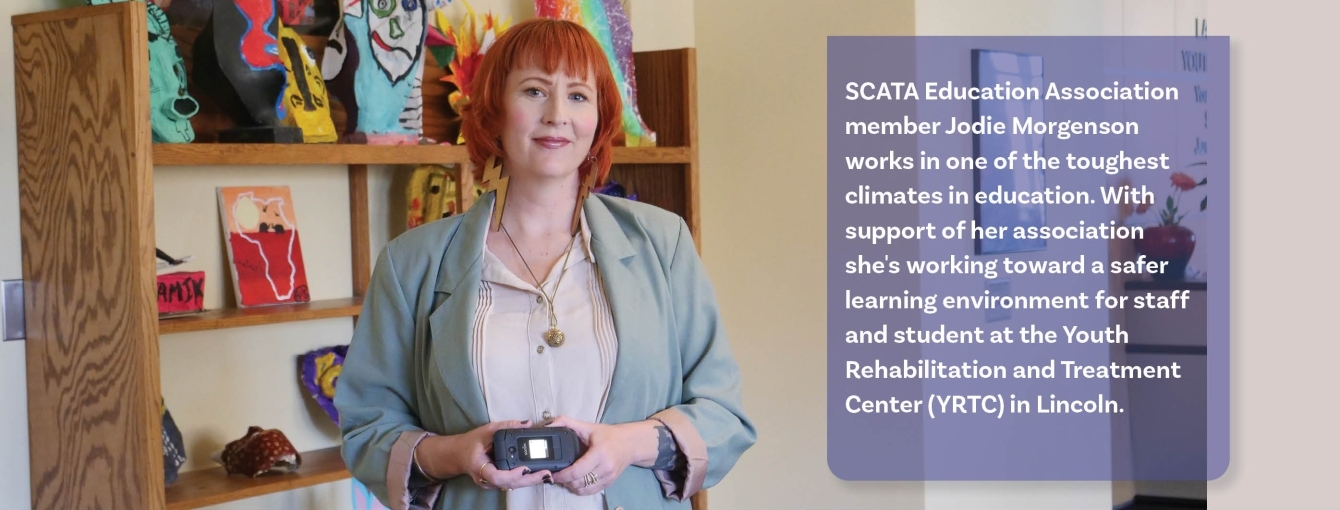Beyond the Panic Button
Teacher Triumphs in Classroom Safety Accommodations
In her 25 years of teaching, Jodie Morgenson says working with students at the Youth Rehabilitation and Treatment Center (YRTC) in Lincoln has been the most rewarding. The secure facility offers intensive behavioral management treatment for students with high acuity behavioral needs.
“This is my favorite job ever,” Morgenson said. “I spent 20 years in the classroom before coming to YRTC. I didn’t always see the positive influence I had on my other students in the ways I can see in my students at the YRTC. They make extraordinary gains in a short amount of time. I get to help my students see that school is not a bad place and that learning is worthwhile.”
As with any secure facility, there are protocols in place to ensure the safety of students and staff. For example, the YRTC classroom is locked from the outside, teachers at the facility don’t carry keys for the classroom door, they are not allowed to carry personal cell phones, and they are not equipped with radios. Behavior staff inside the classroom are equipped with keys and a radio. The classroom also has a panic button in case of an emergency. Morgenson and other educators in the facility are trained in a system of de-escalation called, “Handle with Care” but are instructed that only as a last resort are they to physically intervene in the event of an altercation
“In our facility, no teacher has ever had to physically intervene because we have behavior staff,” she explained.
Worst-Case Scenario
Last year, Morgenson was in her classroom when two students began fighting with a behavioral staff member. Morgenson and a staff trainee were the only other adults in the room at the time. The staff member who was being attacked was the only one with the keys to get out of the classroom or a radio.
“I couldn’t get to the panic button because it was across the room from where the attack took place and classroom furniture was in the way,” Morgenson recalled. “I was attempting to verbally de-escalate and assess whether or not I could physically intervene. We had no way to call for help, and no way to leave the classroom to get help. I felt powerless because both boys were bigger and stronger than me.”
Luckily the behavioral staff member had radioed for additional support before being attacked but he had not signaled for immediate help, or a “level one” response. It took a while for help to arrive.
“Of course, if you’re watching a man get beat up in a classroom, it feels like an eternity. I can’t imagine what it felt like for him.”
After additional staff intervened to break up the fight and the staff member who was attacked sought medical attention, Morgenson went back to teaching.
“I went and taught class for the rest of the day in the very room where this attack happened,” she said.
In the days and weeks that followed, Morgenson says she felt an unsettling sense of alarm while teaching.
“Something broke in me at that point. I didn’t feel safe going back into that room where I couldn’t get out if I needed to without the assistance of another person,” she said. “My brain kept going to ‘What if this happens again?’ Then there were times when I was left in my classroom with staff who didn’t carry radios.”
Morgenson says many of her colleagues reached out to check on her after the incident while others tried to comfort her by telling her that witnessing this kind of violence would eventually become less shocking over time.
“I know some people handle trauma differently. I had people saying things like, ‘Well, you know where you work and this is just one of those things we have to deal with here,’ and I just felt like, ‘I don't want to become desensitized to something like that. It should have upset me. It should upset anyone who witnesses it.”
YRTC students are already undergoing treatment to address their behavioral, mental health, and substance abuse needs. Therapists use an integrated care model to address co-occurring issues. With that in mind, Morgenson’s primary concern was the need for help and the inability to communicate from inside a locked classroom. She took her concerns to her principal and superintendent.
Small but Mighty
Morgenson is a member of the State Code Agencies Teachers Association (SCATA). Members in this small local are also state employees working under the Department of Health and Human Services. This means that not only are members beholden to a principal and a superintendent, they are also subject to state rules and regulations as well as facility rules overseen by Lancaster County.
“I was being told, ‘we hear you, but you can't have a radio. We can't give you a key and here's why.’ And we don't know what to do,” said Morgenson. “They said ‘let us think about it and we’ll get back to you.'”
Morgenson didn’t just wait. She contacted her NSEA Organizational Specialist Mandy Faripour and began keeping a detailed record of her requests for safety accommodations and the response from supervisors.
“If I could give advice to any member going through something similar, it would be to keep receipts,” said Morgenson. “If something feels off, start putting it in writing.”
SCATA decided to act as a group, sending a letter and timeline of their safety concerns to administrators. On the recommendation of Faripour, SCATA members called for a meeting.
“We had some very specific asks. If teachers can’t have keys or radios, what is something we can use? We felt that teachers needed a way to communicate that’s not Webex. I’m not going to send an email saying ‘HELP! Someone’s getting attacked,'” Morgenson said.
Finding a solution, even with her principal and superintendent and her local association on board, was challenging. The logistics of being in a secure facility means that Morgenson doesn’t have one set classroom, she travels with a cart to several areas of the building to teach.
“As state employees in a county building, there is an extra layer of red tape, but our members really supported each other to inch their way to improvement in one of the toughest climates in education,” said Faripour. “SCATA is a small but mighty local.”
Finding a Solution
SCATA members remained persistent that their concerns be met with a solution that would satisfy both the state and county regulations for the facility.
“I had to keep reminding myself that I wasn't asking too much,” said Morgenson. “I was made to feel like I was being crazy and that I didn't know how to do my job. That is something I am very confident in. I know that I'm a good teacher. I know how to run a classroom, and it doesn't matter who the students are, I got this.”
In the end, their perseverance paid off. Teachers would be given a facility-approved phone: a flip phone that would be able to call just one number—the Lancaster County facility control.
“It was definitely a victory. I mean, it was a compromise, and there's nothing wrong with that. I was glad that they were willing to work through it with me. I do wish that it would have been treated as more of a priority than it was but ultimately, I took the W for sure,” she said.
A Priority for NSEA
Fostering school environments where educators and students feel safe and supported is a priority of the NSEA. The Association advocates for policies at the state and local level to promote mental health support, address school safety concerns, and collectively bargain to ensure that teachers have the resources, training, and working conditions they need to be successful.
L.E.A.R.N — Providing valuable learning opportunities for educators: LearnNebraska.org Visit Website








